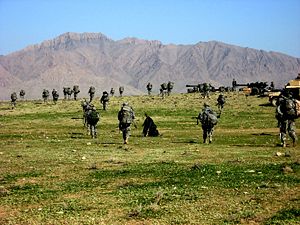| Operation Achilles | |||||||
|---|---|---|---|---|---|---|---|
| Part of the War in Afghanistan (2001–2021) | |||||||
 82nd Airborne Division patrol the Ghorak Valley of Helmand Province in southern Afghanistan during Operation Achilles, March 6. | |||||||
| |||||||
| Belligerents | |||||||
|
Coalition: |
| ||||||
| Commanders and leaders | |||||||
|
|
| ||||||
| Strength | |||||||
|
|
10,000 fighters (Taliban claim) ~4,000 insurgents (according to NATO sources) | ||||||
| Casualties and losses | |||||||
|
Total: 35 killed |
Estimated between 750-1,000 killed 28 captured | ||||||
Operation Achilles was a NATO operation, part of the War in Afghanistan. Its objective was to clear Helmand province of the Taliban. The operation began on March 6, 2007. The offensive is the largest NATO-based operation in Afghanistan to date. NATO officials reported that, contrary to previous operations, Taliban fighters were avoiding direct confrontation in favor of guerilla tactics.
It was led by British ISAF forces and focused on the Kajakai Dam and the towns in the area, which is a major power source for Afghanistan that had not been functioning for a number of years. One part of the mission was Operation Volcano, where British Royal Marines successfully cleared a large Taliban complex near the Kajakai Dam,[2] as well as Operation Kryptonite which actually saw the clearing of the dam by allied forces.
- ^ Pierwsza misja bojowa GROM w Afganistanie (pl) Archived January 14, 2009, at the Wayback Machine
- ^ Royal Marines clear Taliban from key Afghan dam, UK Ministry of Defence Archived February 13, 2007, at the Wayback Machine